 |
|
 6-Apr-2020, 7:36 PM
6-Apr-2020, 7:36 PM
|
#1
|
|
Antenna Enthusiast
Join Date: Mar 2016
Location: Beach Park IL
Posts: 318
|
Extending a Stellar Labs 30-2476
Hi All,
Looking for some advice. This is a hobby project and it is my first attempt at modifying any antenna. If not successful, nothing ventured nothing gained...
A while back in 2011 a member on the help with reception forum made a post. He came back several years later, to follow up. "Wizwor" replaced his highly regarded Y10-7-13 with a modified 30-2476 with extensions of not one, but two front sections from two donor 30-2476's. His reception was much better than the original Y10.
http://forum.tvfool.com/showthread.php?t=2333
https://freetvforme.wordpress.com/20...b2#comment-921
So, I decided to take on a similar project. Amateur DXing. These are great VHF Hi antennas and relatively inexpensive and with the "Buy 4 discount" and another discount I got all 4 for $120, so I want to:
1) Extend the boom with another section and..
2) Build another the same and pair them by combining them using separate RCA PREAMP1R. Along with 2 Antenna Direct 91XG's See diagram :

I do my own Coax, so I'll be sure to make all cables the same length. I'll join them with a Holland Combiner after preamping with the RCAs. I like the RCAs because they double as a UVSJ.
I did some measurements and the directors taper smaller and smaller to the front of the stock antennas. So, I have some front sections from the two donor antennas but the rearmost directors would be wider than the front most directors on the two base antennas.
I have a diagram:
So, here's what I've got so far:

Factory stock:

Extended:

Here's the boom spacing, I could close the Distance about 4" by putting the Antenna to the inside of the "U" which is 1 3/8 " aluminized exhaust tube.:

Here's how I imagined rearranging the directors:
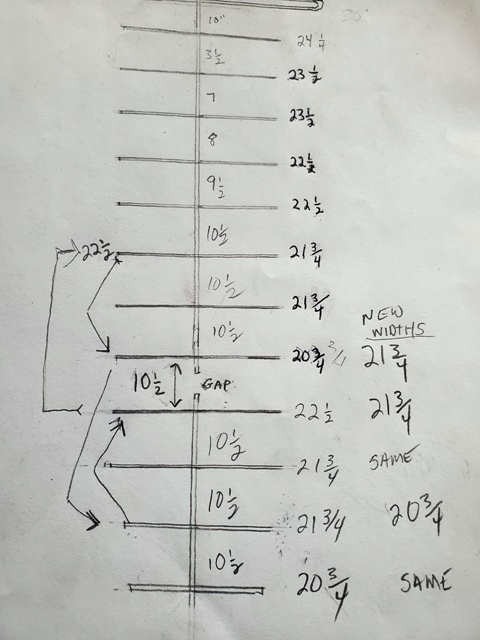
So I looked at some Antenna modeling software but it's too intimidating to be sure. That's why I'm here for advice. Tom Ballister used a signal spectrum analyzer to modify his Y10 7-13. I wished he have done the 30-2476, I would just copy his design!
Here's a list of my current questions.
a) What should the director spacing be?
b) What can I use to join the donor section?, there will be a gap and I can't find the right size square box tubing to sleeve the boom on the outside or inside. .655" ID .710" OD or 16.350 ID 18mm OD
c ) Vertical stack or side by side? With either, what should the spacing be?
d) Will the "u" between the booms disrupt the signal if it's below the reflector?
e) Should I use any of the rear section? Directors etc...
Subquestion, why do the Y10 7-13 have two dipoles? since I have extra dipoles could they be used somehow?
Now, I have two complete rear sections left over, Dipole, directors and baluns, 2 of each, should I be using any parts off of those?:

Last edited by bobsgarage; 23-Oct-2020 at 8:18 PM.
|

|

|
 7-Apr-2020, 7:21 PM
7-Apr-2020, 7:21 PM
|
#2
|
|
Senior Member
Join Date: Jan 2010
Location: Dallas, TX
Posts: 173
|
Interesting project, Bob.
Quote:
Originally Posted by bobsgarage

... even with modeling software that the results are purely empirical.
|
Yes true.
Many models that I have seen, especially at UHF, fail to account for everything that can affect results.
Partially because NEC2 makes it difficult and partially because of failure to appreciate small details.
What modeling can do (if the model is accurate) is to provide insight and guidance.
Insight into how parameters affect results. Vary this, to see effect on that.
Quote:
|
Here's a list of my current questions.
|
Quote:
|
a) What should the director spacing be?
|
Unless one is seeking the last 0.1 dB of gain, small variations in director spacing are not critical.
Start with existing factory spacing, or the wide spacing could be OK.
Quote:
|
b) What can I use to join the donor section?, there will be a gap and I can't find the right size square box tubing to sleeve the boom on the outside or inside. .655" ID .710" OD or 16.350 ID 18mm OD
|
Have used round aluminum tubing to sleeve inside of these booms
DX Engineering sells 6063-T832 that should be strong enough for this application.
https://www.dxengineering.com
Another option would be to omit one director and shorten the boom appropriately to use factory couplers.
Quote:
|
c ) Vertical stack or side by side? With either, what should the spacing be?
|
Optimum spacing depends on antenna aperture (related to gain) and desired channels.
Higher gain and Lower channels would indicate wider pacing.
Maybe maximum spacing would be about 7 feet.
Wide spacing tends to increase gain and raise sidelobes.
Conversely, closer spacing yields lower gain and a better overall pattern (less sidelobes).
Vertical spacing behaves much different than horizontal spacing.
There is more coupling between antennas stacked vertically,
this affects antenna impedance, usually in a undesirable way.
Wider spacing vertically tends to minimize the undesirable coupling.
For performance of vertical stack to be mostly predictable, in terms of gain and pattern,
the antenna should be high above ground (preferably about 10 spacings high or more).
This height helps to make each antenna see the same signal.
Horizontal stacking is less afflicted by mutual coupling.
And, each antenna essentially sees the signal relative to ground.
Quote:
|
d) Will the "u" between the booms disrupt the signal if it's below the reflector?
|
If mast mounted relatively close to reflector, not much affect on gain.
It can affect the pattern by filling nulls.
Given that you have provided some vertical spacing with the U-pipe;
The further away from the driven element toward front of antenna,
the more likely horizontal pipe is to interfere.
For horizontal metal, more vertical spacing and further back is better.
The idea is to minimize exposure to the antenna aperture.
Quote:
|
e) Should I use any of the rear section? Directors etc...
|
You could cut the reflectors and make directors of them.
Probably need a longer boom to effectively use more directors.
Quote:
|
Subquestion, why do the Y10 7-13 have two dipoles? since I have extra could it be used somehow?
|
The Y10-7-13 has two dipoles (driven elements) to achieve sufficient bandwidth to cover channel 7 thru 13.
High band VHF (Ch 7-13) is considered moderately wideband for a Yagi antenna.
The Y10-7-13 was designed before modern computer modeling was feasible.
Computer modeling helps with designing Yagis for wideband performance.
The additional driven element in the Y10-7-13 actually cost a small amount of gain,
that was a tradeoff.
Driven elements generally are not as effective as parasitic element in increasing antenna gain.
Question:
What is the bending strength of your 1 & 3/8 exhaust pipe?
Comment: There can be a strong rotation force due to wind,
trying to rotate the U-pipe and antenna assembly downward.
Need sturdy non-rotatable mast to U-pipe mount.
.
Last edited by tripelo; 7-Apr-2020 at 7:35 PM.
Reason: clarify horizontal metal
|

|

|
 9-Apr-2020, 12:57 AM
9-Apr-2020, 12:57 AM
|
#3
|
|
Antenna Enthusiast
Join Date: Mar 2016
Location: Beach Park IL
Posts: 318
|
Build details...
Tripelo, thank you for your Insight. You asked me about the bending strength of the inch and a half aluminized exhaust tubing that forms the crossbar between the two booms. Tubing is fairly stout.
I didn't notice it till I mocked up the antennas in my shop and saw one of the uprights wasn't exactly parallel / level. When I brought the tubing back, I thought he would want put it back in the machine but he said no we can tweak it by hand. It takes a machine to bend it, but you can tweak it with your full body weight (215 lbs) a few degrees. Which is in fact, how we got the bend perfect.
I decided to go with the drill holes already available on the forward section from the donor 30 - 2476. It seemed that the pattern was 10 1/2" anyhow towards the front. So what I did was rearrange the front sections directors taking the wider ones from the donor section and adding them to the existing antenna and vice versa with the smaller ones from the base antenna and moving them to the donor section that forms the extension.
This created a not so easy to solve problem when joining the donor section to the existing antenna. The director spacing would have been too close so I went to my local hardware store to see if I could find some square box tubing to sleeve the inside of the two antennas and thereby creating an extension. I definitely could not have used the clamp that goes between the two sections because of the 4" gap.
In this way I was able to keep a 10 and a half inch spacing on the front directors. Not knowing what else to do, I figured that's all I can do. There was a lot of drilling to do after installing these reinforcements so I could reattach the directors. That was fairly easy to do and I have my son do it to learn how to operate a drill. And of course aluminum drills quite easily.


However, that size box tube for sleeving was not available but I did find some "C" channel that was exactly the right size to slide inside. Not what I wanted but it would have to do. I later found some "C" channel that fit the outside also. So I decided to go the length of these 8 foot sections inside the Boom length and braced it from underneath using the larger 8 foot U channel. The photo here shows the "C" channel but doesn't give a good idea of how it was used. I'll supply an end-on picture later....

This was the only solution I could come up with on a short notice. I would say that it is still somewhat saggy. I also decided to leave the excess of the "under brace" hanging past the extension boom simply because I don't know if I want to add another section and I don't think it will hurt anything.

The following photos show the amount of sag in the booms, possibly affecting the reception by not allowing the directors to stay on the same plane:
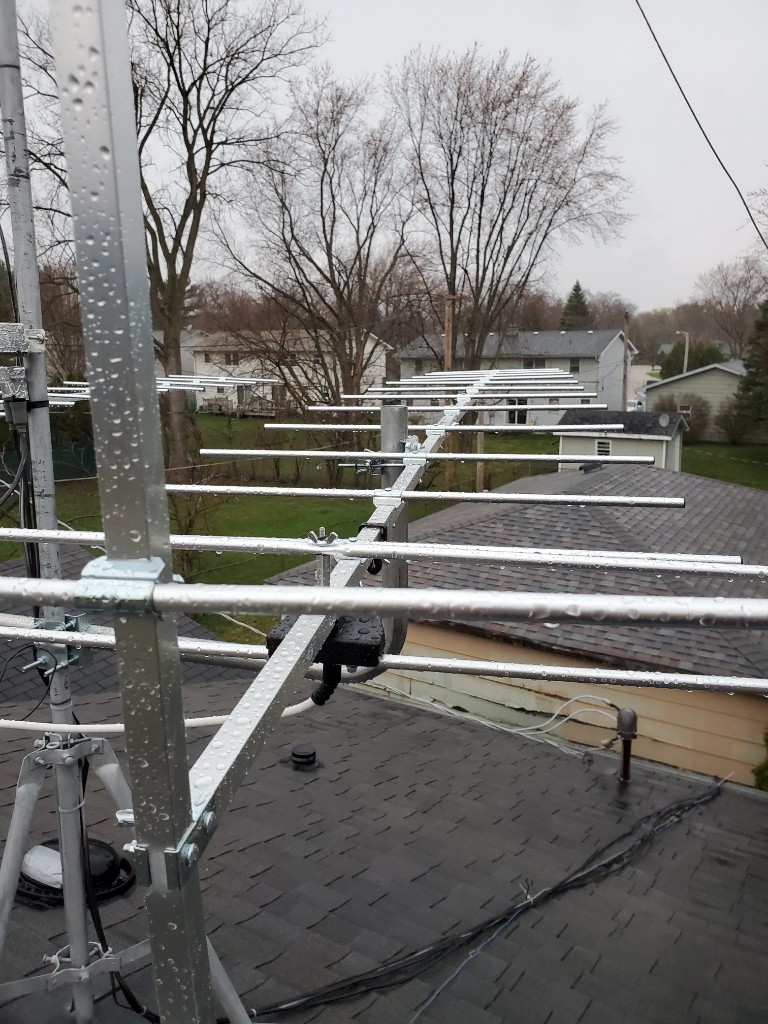

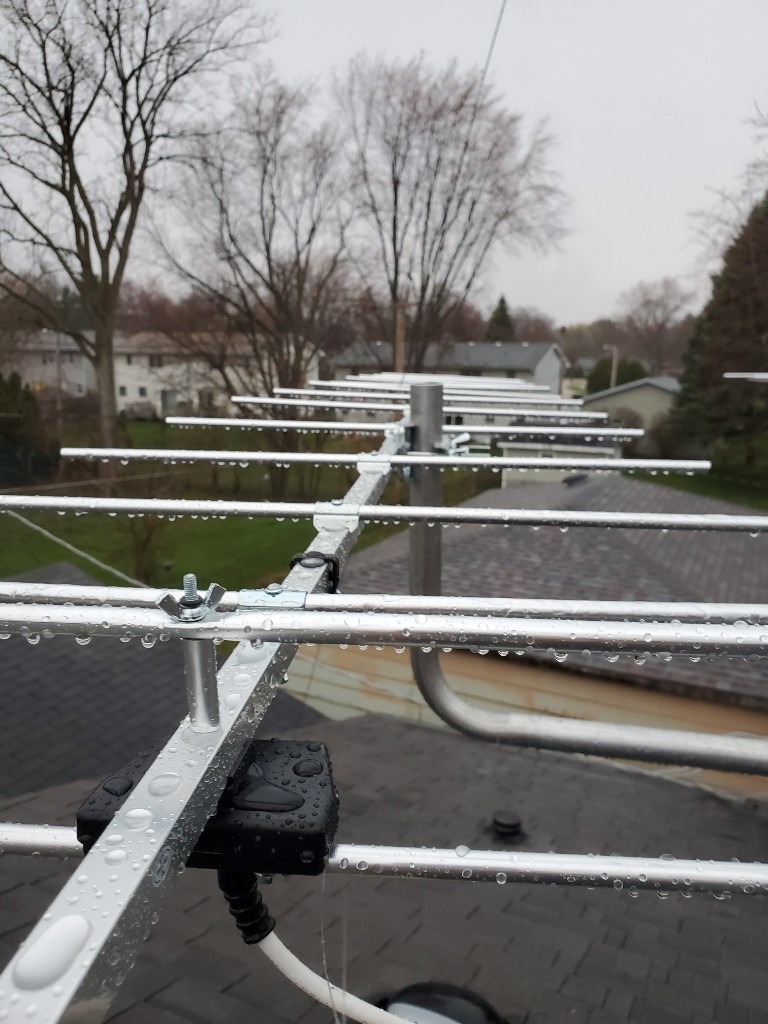
I may need to put a support wire at the end of the boom up to some sort of upright to pull the end of the boom up to take the sag out of it.
Last edited by bobsgarage; 23-Oct-2020 at 8:30 PM.
|

|

|
 10-Apr-2020, 3:08 AM
10-Apr-2020, 3:08 AM
|
#4
|
|
Member
Join Date: Oct 2011
Posts: 55
|
I'm jealous of all that sky. My home is surrounded by oaks, maples, red pines, and white pines. The red pines are tall trees with a tuft of needles at the top that sway in any wind.
How is your reception?
|

|

|
 10-Apr-2020, 5:49 PM
10-Apr-2020, 5:49 PM
|
#6
|
|
Senior Member
Join Date: Jan 2010
Location: Dallas, TX
Posts: 173
|
Quote:
|
Originally Posted by bobsgarage
Here is a scan comparing my one operational 30 - 2470 versus the two paired up and extended:
...So, why is the signal just mediocre?
|
The blue trace (antenna pair) shows a dip in middle of RF 8 spectrum.
That is indicative of two signals interfering with each other (out-of-phase).
An out-of-phase condition can result from:
* Multipath - the signal from the station arriving from two different paths,
one path delayed or advance relative to the other.
* Phase unbalance in Antenna system
One antenna providing a signal that when combined with phase opposing
the signal from the other antenna.
There are about five places in your setup (shown in initial post) where
phase misalignment could occur:
1. The balun at the antennas
2. Unequal coax lengths from antenna to preamps
3. RCA Preamps, Internal filters aligned different yielding phase differences
4. Combiner - Internal circuitry unbalanced
5. Unequal coax lengths from preamps to combiner
Seems, most likely suspect is the preamps (#3 above).
There are several Inductors (L) and capacitors (C) at input and output
of the RCA preamps. The L & C have to be hand tweaked for best signal
amplification, but there is no attempt to make one preamp identical to another.
If the preamps could be bypassed with F-81 connectors (barrels).
The signal would be lower, but if the spectrum was flatter, that might add insight.
May need to turn off power to avoid damage to power source.
If spectrum was flatter, then compare dual antennas without preamp
to single antenna without preamp.
------------------
If it appeared that cancellation was still occurring, check #1 above:
Might try switching baluns from from spare Driven elements (Folded dipoles) ,
to determine if the baluns were source of phase difference.
Quote:
It's possible the sagging in the antennas is causing the directors
to be out of alignment with the dipole?
|
Doesn't seem that would have much affect on phasing. Very tiny
(almost not measurable) affect on gain.
Quote:
|
The funny thing is some UHF channels come in perfectly. Even from the opposite direction;
|
Have seen similar performance with another different set of long Yagis.
.
|

|

|
 10-Apr-2020, 8:14 PM
10-Apr-2020, 8:14 PM
|
#7
|
|
Antenna Enthusiast
Join Date: Mar 2016
Location: Beach Park IL
Posts: 318
|
Tripelo! Thanks for your comments. I did another rescan after "Straightening" the booms with a cable over the top.
Bear with me as I can't access the print screens from my scan but at least, but the signal improved a bit, I'll post those shots later.
I am going to investigate all these items:
1. The balun at the antennas:
OK, I can swap those out easily, will do that after all these other have been adressed:
2. Unequal coax lengths from antenna to preamps
Well, since I made my own coax and was pretty damn close measuring, I'll rule that out for now. But, I will need to make new cables for the final set up when I know what that is.
3. RCA Preamps, Internal filters aligned different yielding phase differences
OK, Just to clarify, I may not have mentioned earlier, I am using the Winegard LNA-200 (right now) on this array after combining. I do want to replace it ASAP
I do have an RCA PREAMP1R but it is on the upper array combing the comparing antennas, a 30-2476 and HDB91X. If and when I get this array working and I combine it with my 2 91XG's I will try to use the RCA preamps, sorry for the confusion,the RCA's are in my final plan drawing.
4. Combiner - Internal circuitry unbalanced
I am using the Holland GHS-2PRO. It was recommended. However, I did buy 4 so I can swap them out and recheck. I also have other combiners. I have a Winegard CC7870, but I was hesistant to use that.
5. Unequal coax lengths from preamps to combiner
That won't apply, at least for now as I am pre-amping the signal after combining. That brings up a question though. What are the opinions on preamping each antenna before combining? I had considered preamping with a low noise preamp before combining. Like the KT-200.
Also, I have seen and read that the LNA-200 is a very noisy amp, so I did order a Kitz Tech KT-200 for this project. 5.1 dB difference on VHF!
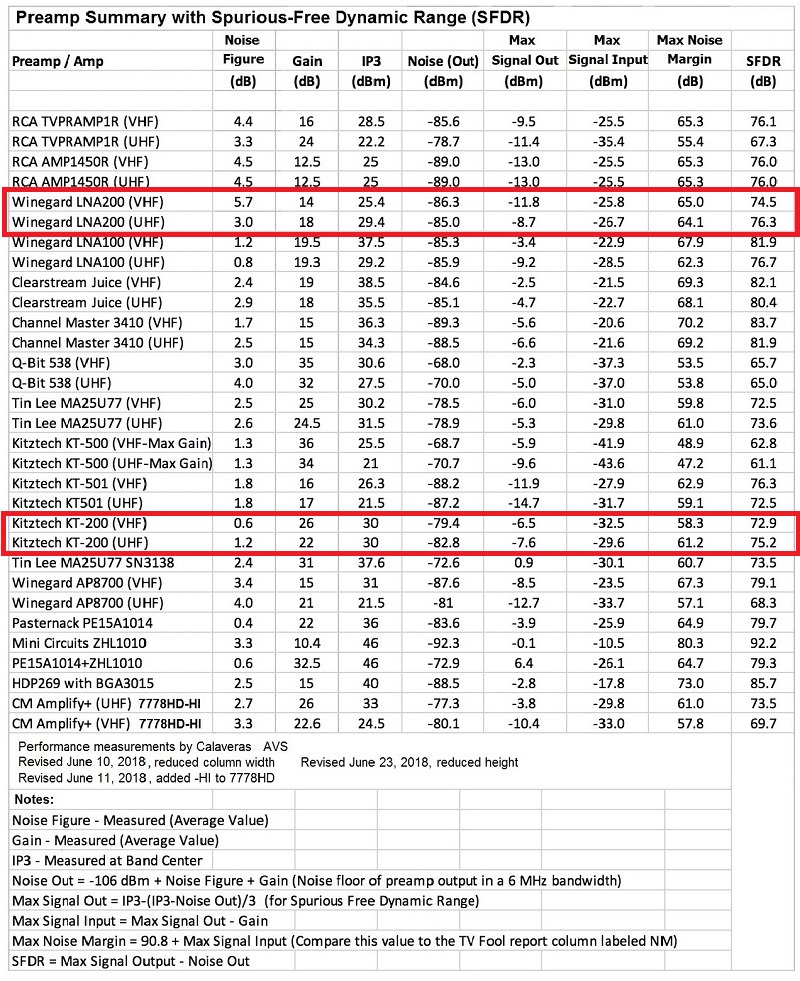
The other possibility that it could be... Maybe most likely?
In order to avoid the guy wires for the upper array, I have had to shift the antennas several times and last night before climbing off the roof for the last time, I saw the reflector were about an inch or two out of alignment. Also I will get out my tape measure to make sure the boom separation is equal.
How much effect can the thin guy wires have? At least one 1/8" cable passed between two forward directors.
I noted that the aim had shifted also, I'll retrain the aim.
Thanks, Bob
Last edited by bobsgarage; 10-Apr-2020 at 8:23 PM.
|

|

|
 11-Apr-2020, 1:54 AM
11-Apr-2020, 1:54 AM
|
#8
|
|
Antenna Enthusiast
Join Date: Mar 2016
Location: Beach Park IL
Posts: 318
|
Todays Testing
Well, Thanks Tripelo for the suggestions, I figured some testing was in order to isolate the reception issue.
First, I decided to square up every thing, I readjusted the cross bar and readjusted the antennas for a nice 90 degree boom to crossbar angle. I then readjusted the boom angle to make the two antenna perfectly the same. I then measured the booms and adjusted them to be perfectly parallel. After all was square I tweaked the boom cables a bit. The rear reflectors are parallel also. Ready for baseline test:

Next test.
East antenna only:

West antenna only:

Now, swap dipoles/balun east antenna w west antenna balun:

West antenna w east balun:

Now both antenna with swapped baluns:

For the final test, I decided to try the Winegard CC-7870 coupler. No real change I think...
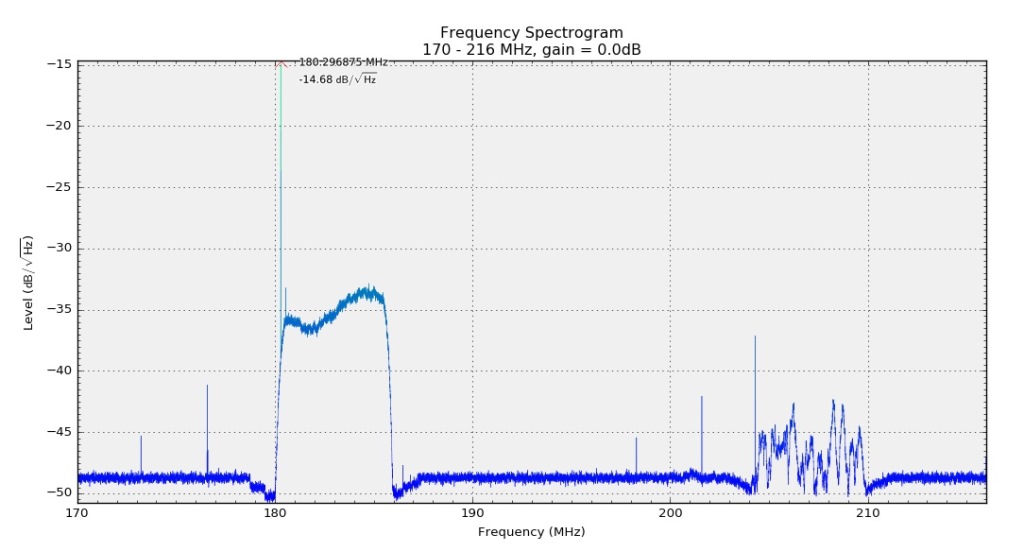
I can do more tests tomorrow. Good exercise climbing that ladder!
Last edited by bobsgarage; 11-Apr-2020 at 2:00 AM.
|

|

|
 11-Apr-2020, 1:35 PM
11-Apr-2020, 1:35 PM
|
#9
|
|
Senior Member
Join Date: Jan 2010
Location: Dallas, TX
Posts: 173
|
Reference 2nd and 3rd images in previous post:
http://forum.tvfool.com/showpost.php...91&postcount=8
Since the 'East Antenna Only' and the 'West Antenna Only' showed evidence
of phase cancellation (dip in the spectrum), that seems to indicate
that the signal self interference is outside the antenna pairs.
---------------
Reference 2nd image (green trace):
http://forum.tvfool.com/showpost.php...88&postcount=5
This antenna does not show the phase cancellation.
What could be the reason? Is this antenna at a different height?
Each of the dual antennas exhibit symptoms of phase cancellation and
the 3rd does not. If the 'blue-trace' antenna is at a different height,
then possibilities:
* It is at a height where ground reflection reinforces signal, whereas the
dual antennas are at a point where ground reflections interfere.
* Or, Some other source of external reflection may be present.
----------------------
The final scan with the Winegard CC-7870 coupler shows increased strength.
Most signals do vary if the station is not LOS and considerable distance
away. Could this be because the signal from the station varies with time?
Otherwise, it could mean that the Winegard CC-7870 coupler performs better
(less loss) than your previous combiner.
.
|

|

|
 11-Apr-2020, 3:47 PM
11-Apr-2020, 3:47 PM
|
#10
|
|
Antenna Enthusiast
Join Date: Mar 2016
Location: Beach Park IL
Posts: 318
|
More baseline testing
Happy Saturday!
I'm ready to do some testing but not sure what to test today!
So first things first. First thing this morning I did another comparison after my small changes.
Blue trace is my new dual 30-2476 extended versions LNA-200 Pre-amp.
Green trace is the Older array with one stock 30-2476 paired with a HDB91x and the RCA PREAMP1R.
Each has their own cabling RG-6, dual shield.
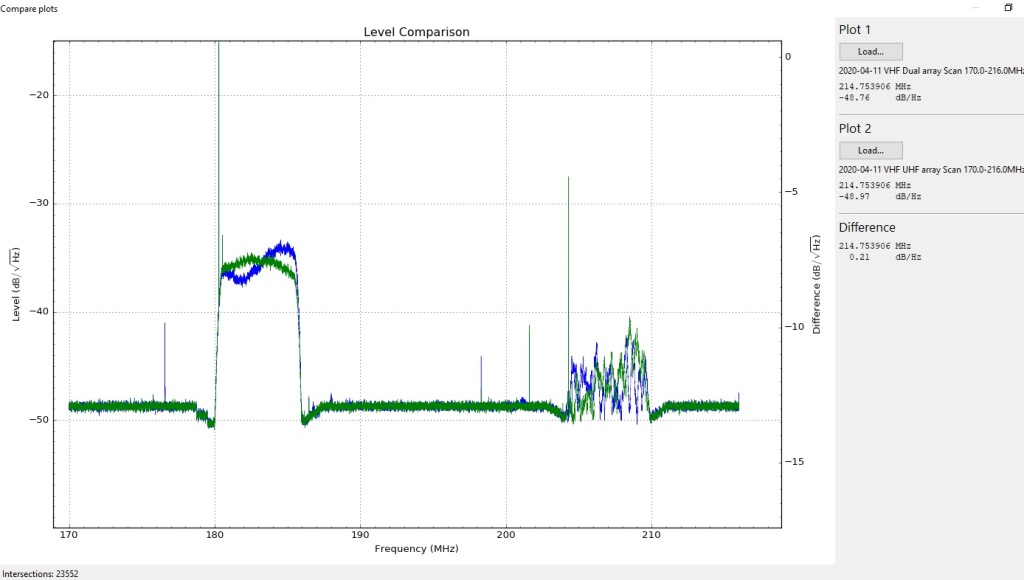
Here's the test array. I did the dual 30-2476 lower on the mast becase it is easier to work on and observe for test reasons, The booms are about 4' above the roof peak.
All antennas are pointing to Milwaukee,355 degrees north, 49 miles distant. Just one VHF station, RF 8 (10.x & 36.x) The other bump is RF12 (2.x) south 168 degrees.

Last edited by bobsgarage; 11-Apr-2020 at 5:21 PM.
|

|

|
 11-Apr-2020, 5:27 PM
11-Apr-2020, 5:27 PM
|
#11
|
|
Senior Member
Join Date: Jan 2010
Location: Dallas, TX
Posts: 173
|
Quote:
|
Originally Posted by bobsgarage
Happy Saturday!
I'm ready to do some testing but not sure what to test today!
|
Thanks for the image.
The location of the single antenna may be a better location with respect
to multipath (likely ground reflections).
Best current guess; the problem is external and related to height.
Height is often a consideration:
The following graph from posts starting here:
http://forum.tvfool.com/showpost.php...8&postcount=79
illustrates this height effect, to a small degree:

Note:
The graph shows the average signal strength of 27 individual channels combined
versus height.
The heights in the image around 20ft and from 25 to 30 feet
showed evidence of multipath cancellation of signal.
The effects will be different for every location and channel, but is often present.
Mostly the interference comes from a ground reflection (which is delayed
due to longer path) being received simultaneous with direct path signal.
There will be heights where these two signals are in phase and other
heights where the two signals are not in phase.
This graph for three individual channels shows effects more clearly:

---------------------------
If the horizontal stack were mounted at the location where the single
antenna is located, that could provide more insight.
.
Last edited by tripelo; 12-Apr-2020 at 12:10 AM.
Reason: clarify graph description
|

|

|
 12-Apr-2020, 1:26 AM
12-Apr-2020, 1:26 AM
|
#12
|
|
Antenna Enthusiast
Join Date: Mar 2016
Location: Beach Park IL
Posts: 318
|
Got the dual VHF moved up !
I almost didn't move the pair, rain was on the radar.
I definitely wanted to get it done though because I think we're going to have rain the next couple days.
I was only about halfway done when the rain started to fall. I couldn't haul both of the antennas up by myself so I took one of them off the crossbar. Next time I'll take both of them off the crossbar.
I wish I could have measured the spacing between the booms a little bit better but the rain began to fall quite a bit harder. They're kind of pigeon-toed right now judging by looking at the pictures.
So, I ended up plugging in the two VHF antenna array into the VHF half of my RCA PREAMPR1... I used the CC 7870 as the combiner. I'm going to have to make two new cables as they are stretched to their limit. I don't want to break the plastic baluns.
I took the ladder down and right after it stopped raining for a few seconds so I put the single 30-2476 back up on the mast in the lower position. The Spectrum analyzer pattern looks similar to when I had the pair down low like that so maybe it's roof reflections or ground reflections.
I don't think the signal of the two antennas is any stronger than the single antenna even when mounted up high. Still, there's room for improvement I feel.

Last edited by bobsgarage; 12-Apr-2020 at 2:33 AM.
|

|

|
 12-Apr-2020, 2:59 AM
12-Apr-2020, 2:59 AM
|
#13
|
|
Antenna Enthusiast
Join Date: Mar 2016
Location: Beach Park IL
Posts: 318
|
Antenna pics
Last edited by bobsgarage; 12-Apr-2020 at 4:39 AM.
|

|

|
 12-Apr-2020, 3:25 PM
12-Apr-2020, 3:25 PM
|
#14
|
|
Antenna Enthusiast
Join Date: Mar 2016
Location: Beach Park IL
Posts: 318
|
2020-04-12 no changes better results. hmmmm...
Good Morning, the rain subsided overnight, although more is on the way, so climbing back up the ladder today to finish up and possibly some tweaks.
This mornings scan, big improvement!

Here's the difference between the rainy night and the next day, (sunny):

Now, maybe some design improvements.
Last edited by bobsgarage; 14-Apr-2020 at 11:54 PM.
|

|

|
 18-Apr-2020, 1:52 PM
18-Apr-2020, 1:52 PM
|
#16
|
|
Senior Member
Join Date: Jan 2010
Location: Dallas, TX
Posts: 173
|
Quote:
Originally Posted by bobsgarage

... I'm designing my own lossless combiner.
|
Interesting idea, using RG8 with RG11 connector.
Quote:
|
... filling the void inside the combiner. Epoxy? RTV? Liquid Tape?
|
Guessing from your image, probably RTV silicone would be a good candidate.
(Avoid silicone that contains acid, some use acetic acid, smells like vinegar)
Two things to consider:
1. Waterproofing
2. Impedance & Loss
Waterproofing, two approaches:
* Externally sealing the closed case. Any of the three items would probably work.
* Internally sealing. Also any of the three items, but there can be impedance
and loss considerations.
2. Impedance & Loss
If open internally, sealed externally, air dielectric, low loss, but may result in
high impedance due to wide spacing and small wire size.
Silicone has relatively low loss and dielectric higher than air. when using
relatively small wires, can help lower impedance.
For your combiner, the length of the wires internally are relatively short at VHF
frequencies, so impedance bumps (near the connections) may not cause a
noticable effect on performance.
------------------------------------
From another thread:
http://forum.tvfool.com/showpost.php...13&postcount=3
Quote:
|
... I am on a pause for now. Any new Ideas ?
|
No new ideas.
For a Yagi, if other dimensions are suitable,
the length of a populated boom has most effect on gain.
For wideband Yagis, such as for upper VHF, director spacing (within limits)
has small effect.
Director length is sized to accommodate the highest desired channel.
If director is too long, gain on upper channels will be lost.
----------------------
The 30-2476 was designed for channels above the US VHF band, so the
directors could be slightly lengthened to obtain more gain in lower VHF
channels.
One can model such things with NEC2, but to verify the performance, can
require a very stable signal source (such as antenna test range).
The change in gain would probably be difficult to verify with reception
of time varying signals (broadcast stations).
If one is within LOS of broadcast stations and know the expected signal variations.
One could make many measurements of the modified antenna and compare the
average to the average of many unmodified measurements.
If the modification involved lengthening directors, and wished to preserve
coverage of upper VHF, it would be good to at least test gain on
channel 13.
.
Last edited by tripelo; 18-Apr-2020 at 2:27 PM.
Reason: Clarify RTV silicone, director length test
|

|

|
 19-Apr-2020, 1:34 PM
19-Apr-2020, 1:34 PM
|
#17
|
|
Antenna Enthusiast
Join Date: Mar 2016
Location: Beach Park IL
Posts: 318
|
Tripleo,
You said no new ideas but you did give me some ideas. Today is supposed to be a nice day today and I want to get some progress done.
I'm trying to gather enough knowledge and yours is very helpful. You mentioned wider directors helps out with the low end of the hi VHF band. I have wider directors from the two donor reflectors. I could use those towards the back.
First thing I want to do his do some baseline testing with what I have. I have two project antennas I could modify one I'll make it a little bit longer with more directors compare that to my original.
I've got to come up with a plan first though. I'll post my findings here.
I also plan to test my new lossless combiner! I'm kind of excited about that. Thanks to Calaveras over on AVS for the idea.

Last edited by bobsgarage; 23-Oct-2020 at 9:30 PM.
|

|

|
 19-Apr-2020, 1:37 PM
19-Apr-2020, 1:37 PM
|
#18
|
|
Member
Join Date: Jan 2016
Posts: 81
|
Quote:
Originally Posted by tripelo

Interesting idea, using RG8 with RG11 connector.
|
If I recall correctly that is a design that Calveras developed.
|

|

|
 19-Apr-2020, 3:59 PM
19-Apr-2020, 3:59 PM
|
#19
|
|
Antenna Enthusiast
Join Date: Mar 2016
Location: Beach Park IL
Posts: 318
|
Calaveras low loss combiner
Quote:
Originally Posted by Sev

If I recall correctly that is a design that Calveras developed.
|
Oh yes, I edited my post to give Calaveras credit. His instructions were if it was a solid polyethylene insulator to make it 10 inches exactly including the connectors. However I missed that important detail. I used foam insulated RG 8. Apparently that measurement should be 12 in. This is due to the velocity Factor.
These are things that escape me. In fact, 12" may not even be the exact length because every manufacturer publishes their own velocity specs. I don't know the manufacturer of this particular RG 8.
So, back to the drawing board on the lossless combiner. I'll be back.
Last edited by bobsgarage; 20-Apr-2020 at 4:14 PM.
|

|

|
 21-Apr-2020, 4:32 AM
21-Apr-2020, 4:32 AM
|
#20
|
|
Antenna Enthusiast
Join Date: Mar 2016
Location: Beach Park IL
Posts: 318
|
I've made it to the Forum circuit, asking for advice. Luckily for me a couple of guys offered help over here Tripleo and over on AVS Calaveras.
Both agreed that the length of the boom is the most important. Calaveras suggested I would need to double the size of my antenna. Tripleo also gave me some great rule of thumb advice on the directors.
I tried to contact some people who specialize in antenna modeling but I was unsuccessful. Without any antenna modeling I decided to forge ahead and just try add four more directors on for a total of 16 I kept the last four directors the same size which was 21". I used one of the director booms and the holes were already pre-drilled to 10 and 1/2 inches spacing.
How does it work? I don't know yet. I had a storm creeping on me during the final mounting. I had to barely tighten up the mast clamp, wait for the rain squall the stop, jump back on the roof and try to re angle the antenna in the dark. The 40 mile-an-hour gusts made it difficult. I'll have to get back on the ladder tomorrow morning check my connections.

Last edited by bobsgarage; 23-Oct-2020 at 9:32 PM.
|

|

|
 Posting Rules
Posting Rules
|
You may not post new threads
You may not post replies
You may not post attachments
You may not edit your posts
HTML code is Off
|
|
|
|
|

